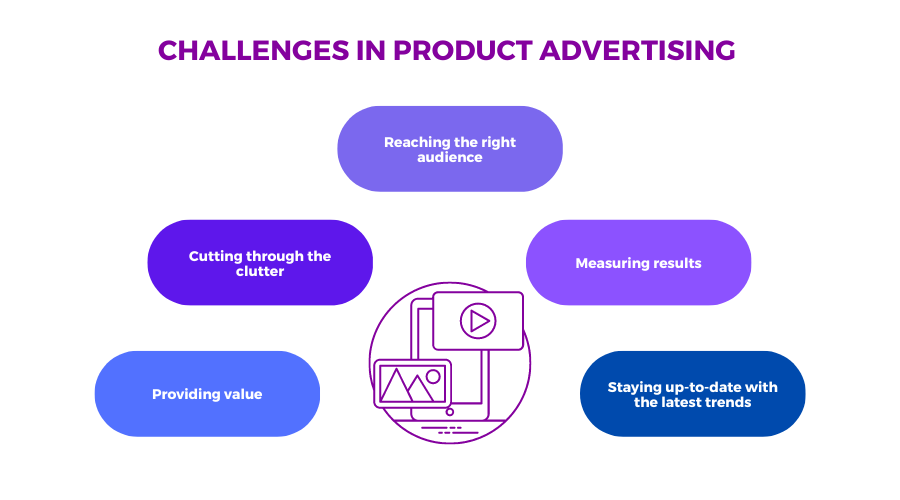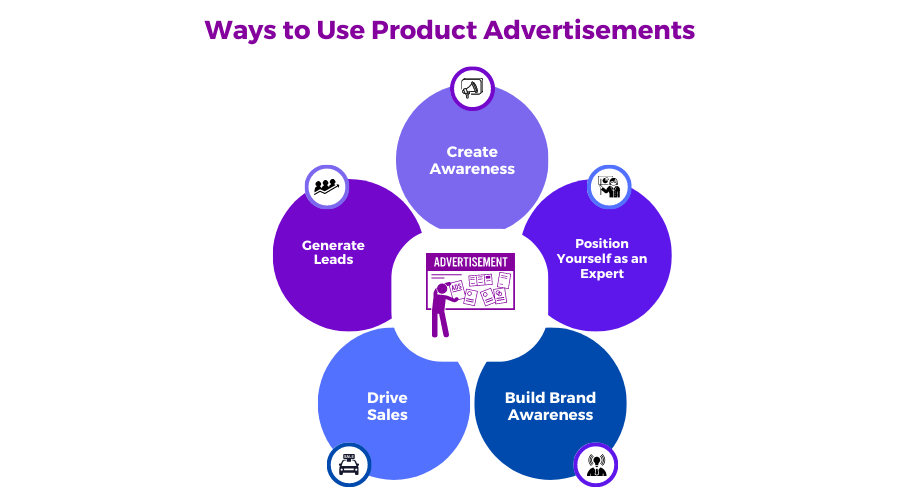What Is Product Advertising? Definition, Types and Tips
October 26, 2023 Max 5min read

Are you trying to find ways to increase the sales of your products? Then you need to learn about product advertising.
“Great advertising, in and of itself, becomes a benefit of the product.” – George Lois.
Advertising is nothing but a link between your products and your potential customers. Your product could end up becoming just another face in the crowd without advertising. However, understanding how to make use of this marketing strategy strategically is the key to effective advertising.
That’s why we’ll be looking at product advertising in depth. By the end of this article, you’ll know how to use product advertising to your advantage to make your business thrive. Are you reading? Then, let’s get started!
What Is Product Advertising?
The Definition
Product advertising is a type of paid promotion that attempts to convince customers to invest in a product. Billboards, the Internet, social media, radio, print, and television are some communication platforms that serve as channels for product advertising.
Advertising your products can help you in boosting sales and get your brand name out there. By focusing on what makes your stuff special and how it can help people, customers will understand why they need it and how it can improve their lives.
To make ads that grab attention, you must think about who you’re trying to reach and what they want. Just listing features isn’t enough. You must also show how those features solve problems or meet people’s needs.
Nowadays, with ads everywhere, your product promos must stand out and catch people’s eyes. You can do that with creative, visually appealing ads targeted right at the right audience in the right places.
The whole point of advertising products is to make people feel like they have to act now, whether buying something, signing up for a service, or finding out more. You want to spark that sense of urgency and convince folks to take action.

Brand Advertising vs Product Advertising
Brand and product advertising are two distinct concepts often used interchangeably. Let’s look at the key differences between these two approaches.
Brand Advertising: Building a Brand Identity
Brand advertising is a marketing approach that fosters and reinforces your company’s reputation. The goal is to grow a dedicated customer base that shares your brand’s identity, values, and overall reputation. The goal is to increase customer loyalty and brand equity ultimately.
Product Advertising: Promoting Specific Products
Product advertising promotes the features and perks of a particular product. It aims to persuade customers to buy the advertised product by emphasizing its unique value proposition.
You can use more informational and persuasive language and target specific customer segments based on their preferences and needs. The primary objective is to increase sales and market share in the short term.
Balancing Both Approaches
Although brand advertising and product advertising serve different purposes, both are critical to a company’s long-term success. A well-executed strategy that balances both can help you drive sales and develop a strong brand image.
Types of Product Advertising
Marketers employ various promotion strategies to showcase their products successfully. Now that you have understood the meaning of product advertising let us explore the seven main types.
- Digital advertising encompasses online promotion via search and display ads. It allows brands to reach audiences across various platforms.
- Social media is a unique channel for product marketing through specialized research and influencer partnerships. Engaging communities on networks helps attract new consumers to pages.You can also easily use social media to promote services. For example, if you need to promote Amsterdam city passes, contact famous travel bloggers for advertising, run social media ads depending on your target audience research, etc.
- Print media like newspapers and magazines maintain influence as advertising venues. Targeted publications provide direct access to relevant readers, and recognition by notable outlets enhances reputation.
- Outdoor advertising employs diverse physical placements like vehicles, banners, booths, and billboards. Adding QR Codes that can be created using a QR Code creator to these ads will ensure you can measure your outdoor campaigns’ efficiency. It widens brand awareness among broader audiences in public spaces.
- Email marketing necessitates careful planning and subtle messaging when promoting products via this digital channel. Experienced marketers apply tested engagement tactics to drive click-throughs.
- Event marketing creates opportunities to directly showcase offerings and cultivate meaningful connections with audiences at expos or conferences. This interactive approach educates attendees firsthand.
- Video ads utilize short, instructional clips within or alongside online videos to convey narratives, boost sales, garner attention, and clearly present information to wider demographics. Combined strategies optimize impact across multiple promotion types.

Benefits of Product Advertising
Let us look at several critical benefits of product advertising.
Distinction in the Marketplace
Effective promotion communicates a product’s differentiating qualities, setting it apart from other options. Highlighting distinctive attributes establishes a competitive edge despite abundant alternatives.
Stimulating Desire
Product advertising, when used wisely, can influence purchasing decisions by creating impressions of greater quality against competitors. The increased demand and enthusiasm encourage higher revenue volumes.
Sales Growth
Product advertising fosters a sense of urgency through timely incentives, aligning benefits with customer wants to motivate immediate purchases. Time-bound discounts encourage impulse buying.
Precise Audience Targeting
Understanding target demographics and alignment with product advantages ensures promotional messaging reaches qualified prospects most likely to convert.
Brand Affinity
While primarily accentuating individual products, product advertising strengthens brand identity by associating offerings with valued characteristics. It reinforces and augments brand perception in the public sphere.
Clearing Up Misconceptions
Promotion serves an important educational role, addressing knowledge gaps or inaccurate assumptions that risk undermining consumer trust and confidence. Clear communications establish an informed basis for purchase decisions.
Tips to Choose the Right Product Advertising Type
Here are some recommendations for choosing the right product advertising type:
Know Your Audience
How will you reach the right audience if you don’t understand them? Analyze your target audience’s demographics, interests, and behaviors. This insight allows choosing platforms and channels aligned with consumer profiles.
Define Objectives
Determine specific goals for the campaign. Is it brand awareness, traffic, sales, or other metrics? Objectives should guide the selection of appropriate advertising models.
Research Options
Explore various product advertising types like social media, videos, and influencer campaigns and evaluate how each option relates to your goals and audiences.
Consider Budget
Advertising costs vary between models. Review the budget to select options offering the strongest return on investment potential.
Test and Refine
Once you have chosen your product advertising types, test them to see which ones perform the best for your goals. Analyze the results and optimize your advertising campaigns to improve their effectiveness.
With a diligent understanding of target consumers, you can make well-defined goals, comprehensive research of available options, budget consideration, and data-driven optimization, an informed choice of relevant advertising types to drive desired business outcomes. Adopting this rigorous selection process sets the stage for product success.
FAQs
To choose the best advertising media for your product, you must consider your target audience, advertising goals, available budget, and the effectiveness of different advertising types. Research various media platforms, such as TV, radio, print, digital, and social media, and determine which ones align with your advertising goals and audience. Test different advertising types to see which ones perform the best, and optimize your campaigns accordingly.
A few common errors in product advertising to avoid include trying to please everyone, failing to connect with your audience, relying excessively on marketing data, failing to diversify your marketing approach, failing to meet expectations, replicating the competition, overlooking the competition, and restricting the marketing campaign budget.
Product advertising is evolving with emerging trends such as interactive advertising, voice search optimization, influencer marketing, personalized advertising, sustainability, and social media e-commerce. Interactive advertising offers a more engaging experience with augmented and virtual reality. Voice search optimization is vital, and influencer marketing is shifting towards micro-influencers. Personalized advertising delivers targeted messages, and sustainability is more prevalent. Social media channels incorporate e-commerce features, enabling businesses to sell products directly.
